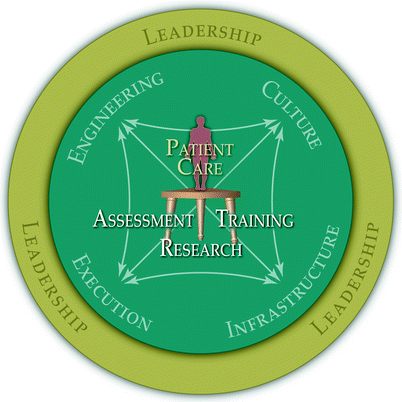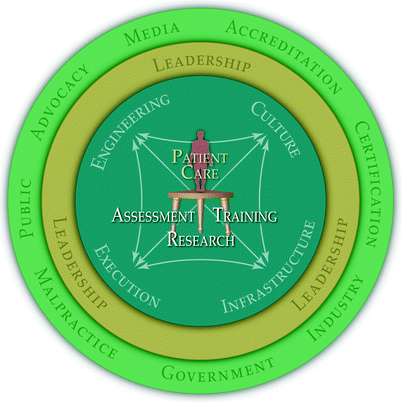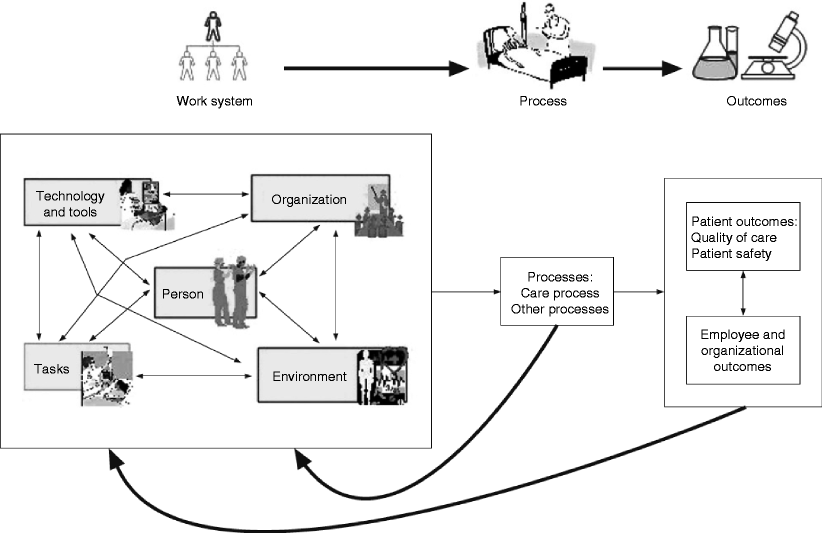The committee proposes six aims for improvement to address key dimensions in which today’s health care system functions at far lower levels than it can and should. Healthcare should be:
1. Safe—avoiding injuries to patients from the care that is intended to help them.
2. Effective—providing services based on scientific knowledge to all who could benefit and refraining from providing services to those not likely to benefit (avoiding underuse and overuse, respectively).
3. Patient-centered—providing care that is respectful of and responsive to individual patient preferences, needs, and values and ensuring that patient values guide all clinical decisions.
4. Timely—reducing waits and sometimes harmful delays for both those who receive and those who give care.
5. Efficient—avoiding waste, including waste of equipment, supplies, ideas, and energy.
6. Equitable—providing care that does not vary in quality because of personal characteristics such as gender, ethnicity, geographic location, and socioeconomic status.
Simulation will not be the panacea for all deficiencies of health systems. However it can be a viable tool for organizational leadership to solve identified safety, effectiveness, efficiency, and equity problems toward patient-centric optimized care. Simulation is but one of many tools (e.g., informatics technologies, root cause analyses, risk management, community services, biomonitoring) available to improve patient care experiences and outcomes. Identifying how simulation adds value to the reformation of health care is an important task for health-care leaders in partnership with simulation professionals.
Facilitating value-driven health care at the bedside, health-care organizations utilizing simulation may serve the “common good” by providing education, assessment, quality, safety, and research. Figure 10.1 highlights the relationship between each component of an organization. From a systems standpoint, delivering competent, professional patient care is central and the immediate need. The mission of an organization therefore addresses how these system components achieve and highlight the centrality of the safety-focused patient experience. It is the seamless relationship of education (training), assessment, research, and care infrastructures that serves patient needs optimally, within an interdisciplinary framework. Organizations do not function independently however and also have relationships and oversight from external entities including the government, industry, media, accreditation bodies, and other agencies (Fig. 10.2).



Fig. 10.1
Integration of simulation into organizational complexity

Fig. 10.2
Integration of simulation into organizational complexity (internal and external)
Although systems differ, we agree with the IOM that patient centricity must be central to any health-care delivery model. We further assert that simulation affords a needed and transformative set of system improvement tools and opportunities for certain reengineering needs that is unavailable (or suboptimal) via other means; this facilitates integration of process components within our (consistently complex) organizations (i.e., systems). In this chapter, we address the current and potential roll of simulation in improving the quality and safety of patient care delivered at the bedside by discussing simulation’s impact at the complex macro-institutional level in a “top-down” rather than a “bottom-up” manner.
Systems Integration from the Perspective of a Simulation Program
Systems integration is defined by the Society for Simulation in Healthcare (SSH) as “those simulation programs which demonstrate consistent, planned, collaborative, integrated and iterative application of simulation-based assessment and teaching activities with systems engineering and risk-management principles to achieve excellent bedside clinical care, enhanced patient safety, and improved metrics across the healthcare system” [5].
Systems integration is a new concept to health care and therefore requires a new and thoughtful approach to meeting these standards. Adopting solutions from other disciplines and industries may offer an innovative “toolkit” that is applicable to the (IOM-driven) transformations essential for health care today.
Systems engineering tools have been used in a wide variety of applications to achieve major improvements in the quality, efficiency, safety, and/or customer centeredness of processes, products, and services in a wide range of manufacturing and services industries [3]. The addition of medical simulation to this evidence-based toolkit is not only complimentary but can enhance the associated transformative effects. Simulation techniques offer opportunities to enhance the accountability of health-care-providers’ skills acquisition through formative and summative training, which offer consistency, objectivity, and demonstrated proficiency in the management of clinically realistic and relevant problems.
Health Care as a Complex Adaptive System
Contemporary clinical medicine not only includes the obvious provider-patient interaction but also includes many complex “system” dimensions in the patient care setting. These include health-care provider performance characteristics; organizational factors including physician, nursing, allied health staff availability, environmental considerations, patient, and family member preferences; and the interactions between these components of the complex system [6]. Within organizations, each component is interconnected and interdependent with other system components. The impact of interactions between system components is difficult to predict since they are often remote in time and space. Inadequacy in such system components can negatively affect care delivery. System-related components (patient flow, work environment, information systems, human factors) contribute to delays and errors in care. The World Health Organization (WHO) has suggested that the (1) lack of communication, (2) inadequate coordination, and (3) presence of latent organization failures are important priorities for improving patient safety in developed and developing countries alike [7].
Outside the conceptual “walls” of an organization, complexity remains. Health care is often not delivered within a single “island-like” independent facility. Often, care delivery occurs within a large enterprise or system of systems of health-care delivery. Care across such system components is rarely seamless. Beyond the (larger) enterprise walls exist environmental forces (see Fig. 10.2) including external regulatory agencies, the press, public perception and other market forces, malpractice, and medicolegal concerns.
Health-care delivery systems continue to increase in complexity because of many factors including improvements in technology, advanced diagnostic technology, complex disease processes, increasing accountability and transparency of internal processes, an aging population, workforce shortages, generational differences, social networking, and mobile technology. These factors will transform both patient-provider and provider-provider interactions. Health-care’s increased complexity and sophistication comes at a price- increased risk of error and poor patient outcome. Sir Cyril Chantler stated, “Medicine used to be simple, ineffective and relatively safe. Now it is complex, effective and potentially dangerous” [8].
A “Systems Approach” to Improving Health-Care Delivery
Although concepts of systems and engineering applications applied to health care may seem novel, large successful organizations have used systems engineering principles for many years. Dr. Henry Plummer, a Mayo Clinic internist from 1901 to 1936, creatively engineered many aspects of the world’s first integrated academic group practice of medicine and surgery and remains a recognized pioneer in conceptually embedding engineering philosophy into the practice of medicine [9]. Plummer’s innovations included an integrated inpatient and outpatient medical record, a “master sheet” clinical diagnoses list for research and practice improvement activities, a pneumatic tube system to distribute records and laboratory specimens across multiple geographic sites, and a color-coded lighting system to support central booking and the patient visitation process. All of these inventions remain in use today. In fact, Plummer’s novel applications served as the origins of the Division of Systems and Procedures at Mayo Clinic in 1947. Dick Cleeremans (Section Head 1966–1982) stated: “The decision by the Mayo Medical Center to hire industrial engineers in those early years was in keeping with the Mayo commitment to the patient, physician/patient relationship and Dr. Plummer’s expectation that the system and the organization of the clinical practice were important and a worthy management activity.”
More recently, Avedis Donabedian popularized the structure-process-outcome framework with which to assess quality-improvement efforts [10]. Donabedian also described the Systems Engineering Initiative to Patient Safety (SEIPS) framework, designed to improve health-care delivery in complex health-care systems (Fig. 10.3) [10, 11].


Fig. 10.3
From Carayon et al. work system design for patient safety: The SEIPS model [11] (Used with permission)
System approaches focus on the working environment rather than on the errors of individual providers, as the likelihood of specific errors increases with unfavorable environmental conditions. The effective system intervention is to design, test, and enhance the system’s components so it can prevent human error and identify a variety of vulnerabilities such as distraction, fatigue, and other latent factors [12].
The “Systems Approach” Meets “Modeling and Simulation”
Systems-based modeling and simulation (M&S) has several advantages for clinical decision support, systems analysis, and experimentation for multivariate system components that cannot be achieved by traditional quality-improvement processes. Computer modeling can simulate processes of health-care delivery by engineering techniques such as discrete-event simulation. In discrete-event simulation, the operation of a system is represented as a chronological sequence of events; events occur at a particular instant in time, thus defining a change of state in the system [13]. Because discrete-event simulation is time oriented (as clinical patient outcomes often are based on timeliness of delivered care), this form of computer-based simulation lends itself well to systems engineering analyses of contemporary complex health-care systems.
Coupling computer modeling techniques (such as discrete-event simulation) to realistic contemporary simulation programs can provide a synergy of process improvement design and analysis offering exceptionally strong opportunities in transformational process improvement. For instance, novel process optimization mechanisms through integration of engineering principles for health-care system analysis, simulation-based drills, and workflow redesigns for testing proposed interventions (virtual clinical trials or quality improvement) before clinical deployment may reduce the potential for preventable harm to patients.
Consider a patient entering an emergency department with acute abdominal pain, possibly due to a surgical emergency, as the beginning of a “process.” Computer models (e.g., a process flow diagram) can readily demonstrate patient time-dependent flow for a population of such patients, between the time of emergency room entry to the definitive surgery. Because many process components must occur (history and physical, laboratory analyses, radiographic imaging, consultations) in both series and in parallel, equations describing such patient “traffic” can be defined, which, if accurate enough, can be descriptors of both current and future performance. Such computer-based models are excellent adjuncts for process improvement via immersive experiential simulation such as drills and in situ simulations.
A stepwise M&S approach follows that illustrates the potential for improved health-care delivery process:
Step one, system monitoring: Graphically define a current practice pattern of individual patient flow within a distinct process of delivered care describing the (in series or in parallel) decisions and patient care activities in branching fashion (e.g., trauma assessment and care delivery within an emergency department).
Step two, system modeling: Develop the individual equations defining the time-dependent parameters of the work process flow diagram. The model must replicate reality within reasonable limits, for realistic patient flow care simulations.
Step three, hypothesis generation and system redesign: Practical aspects of delivered care efficiency are optimized (in a hypothetical basis) by altering components of the flow diagram.
Step four, simulation applications to enhance system performance: In center or in situ realistic simulation is utilized to improve individual or team performance.
Step five, feedback loops sustain process improvement: Data monitoring verifies absence of regression to baseline inefficiencies. Simulation “ping” exercises (see example 8 later in the chapter) or drills are used to assess system performance on a perpetual basis.
The National Academy of Engineering and Institute of Medicine of the National Academies directed attention to the issue of systems engineering and integration with their joint report in 2005, Building a Better Delivery System: A New Engineering/Health Care Partnership [3]. The proposed collaboration between clinicians, engineers, researchers, educators, and experts from medical informatics and management will provide a clinically relevant, systematic approach and a comprehensive solution to many of the challenging problems in clinical medicine.
System Engineering
The overall goal of systems engineering is to produce a system that meets the needs of all users or stakeholders within the constraints that govern the system’s operation. Systems engineering requires a variety of quantitative and qualitative tools for analyzing and interpreting system models (Table 10.2). Tools from psychology, computer science, operations research, management and economics, and mathematics are commonly utilized in systems engineering across a wide array of industries. Quantitative tools include optimization methods, control theory, stochastic modeling and simulation, statistics, utility theory, decision analysis, and economics. Mathematical techniques have the capability of solving large-scale, complex problems optimally using computerized algorithms [14].
Table 10.2
System analysis tools
Tool/research area | Patient | Team | Organization | Environment |
|---|---|---|---|---|
Modeling and simulation | ||||
Queuing methods | X | X | X | |
Discrete-event simulation | X | X | ||
Enterprise-management tools | ||||
Supply-chain management | X | X | X | |
Game theory and contracts | X | X | X | |
Systems-dynamics models | X | X | X | |
Productivity measuring and monitoring | X | X | X | |
Financial engineering and risk analysis tools | ||||
Stochastic analysis and value at risk | X | X | X | |
Optimization tools for individual decision making | X | X | ||
Distributed decision making (market models and agency theory) | X | X | ||
Knowledge discovery in databases | ||||
Data mining | X | X | X | |
Predictive modeling | X | X | X | |
Neural networks | X | X | ||
Many of the systems engineering tools are found within different quality-improvement strategies, including Six Sigma, Toyota Production System, and Lean. But within these methodologies, examples of system engineering tools that have been utilized in health care include [3]:
Statistical process control
Process flowcharting
Queuing theory
Quality function deployment
Failure-modes effect analysis
Optimization
Modeling and simulation
Human-factors engineering
Process Engineering
Process engineering is a subset of systems engineering and represents a system process component, essentially a “building block” of a complex adaptive system (Table 10.3). A process is a set of interrelated tasks or steps that together transform inputs into a common output (i.e., workflow) toward a goal, (such as in the assessment steps involved within the “acute abdominal pain” patient group presenting to an emergency department described earlier). The tasks can be executed by people or technology utilizing available resources. Thus, within the processes of (complex adaptive) systems improvement, a focus within individual processes is a natural phenomenon, while recognizing the interrelated nature of system (process) component parts. The introduction of new processes, such as technology (and support) associated with the introduction of an electronic medical record (EMR), requires business process redesign before such processes are implemented. When, in an effort to meet project management deadlines, engineering processes are rushed or completely ignored, system havoc may ensue.
Table 10.3
Systems engineering versus process engineering
Focus | Systems engineering | Process engineering |
|---|---|---|
Purpose | High-level subsystems or systems | Low-level tasks or steps and the resources/tools required to execute the tasks/steps |
Focus | Relationships of interrelated subsystems | Sequence or workflow of interrelated tasks or steps and associated resources/tools |
Methodology | Design, analysis, control of relationships between subsystems | Establish workflow or sequence of tasks and required resources/tools |
Example of project types | Optimizing patient care processes in a children’s hospital using six Sigma methodology | Reducing inpatient turnaround time using a value analysis approach |
Comprehensive perinatal safety initiative to reduce adverse obstetric events | Improving computed tomography scan throughput | |
Improving handoff communication | Reducing length of stay for congestive heart failure patients using six Sigma methodology |
What Systems Integration Is
In terms of simulation, systems integration (SI) is the recognition of a variety of key principles as one better understands the role and capacity of simulation within the complex adaptive health-care system. This is intended to achieve a functional, highly efficient organization of dynamic teams and processes, interfacing to collectively and artfully optimize patient care. Therefore a simulation program’s impact on an organization’s intrinsic function includes the following principles as they apply to projects that facilitate seamless and optimal effective heath system process integration.
SI projects are:
Leadership and mission driven toward safety and quality goals, facilitating optimized care delivery
Monitored, as appropriate, to assure impact in perpetuity via appropriate metrics
Described by systems engineering principles and tools
Interdisciplinary
Simulation can also be used strategically by the health-care organization to achieve business goals. When building new facilities, simulation can be used alone or within Six Sigma or Lean concepts [15, 16], systems engineering tools, to ensure that a facility develops efficient and effective workflows with input from the staff. The new facility can then be tested in simulation to identify and address any process or human factor issues before opening.
Organizational leaders, including clinicians, risk managers, and/or quality/safety process managers, may approach the simulation program with specific safety initiative. Below are a series of eight case studies highlighting the use of simulation for SI purposes.

Full access? Get Clinical Tree








